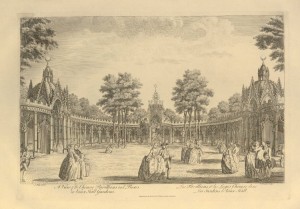Chinese “Houses”, “Pavillions” and London’s Pleasure Gardens
Posted: April 15th, 2013 | No Comments »A rather lovely book out recently and just reviewed in the London Review of Books, David Coke’s Vauxhall Gardens: A History, tells the story of the great pleasure gardens of 18th century London – Vauxhall as well as Ranelagh, Marylebone and others where all manner of fun and mischief was got up to. I’d known of the Chinese pavilions at Vauxhall (below) but didn’t know of the Chinese “House” at Ranelagh Gardens in Chelsea (also below). So worth a couple of pictures I think…
The Chinese Pavillions and Boxes at Vauxhall Gardens
The exterior of the Rotunda at Ranelagh Gardens, the “Chinese House”, and part of the grounds; engraving by Thomas Bowles, 1754.
And the book itself…
From their early beginnings in the Restoration until the final closure in Queen Victoria’s reign, Vauxhall Gardens developed from a rural tavern and place of assignation into a dream-world filled with visual arts and music, and finally into a commercial site of mass entertainment. A social magnet for Londoners and tourists, they also became a dynamic centre for the arts in Britain. By the eighteenth century, when the Gardens were owned and managed by Jonathan Tyers – friend of Handel, Hogarth and Fielding – they were crucial to the cultural and fashionable life of the country, patronized by all levels of society, from royal dukes to penurious servants. In the first book on the subject for over fifty years, Alan Borg and David E. Coke reveal the teeming life, the spectacular art and the ever-present music of Vauxhall in fascinating detail. In the nineteenth century the Gardens remained a popular attraction, but faced increasing competition from new forms of entertainment such as the circus and the music hall and, with the arrival of the railway, the seaside. Nevertheless, they remained a prominent feature of London life right up to their closure in 1859. Borg and Coke’s historical exposition of the entire history of the foremost pleasure garden of eighteenth- and nineteenth-century London makes a major contribution to the study of London entertainments, art, music, sculpture, class and ideology, and puts into a very particular context an unusual combination of subjects. It reveals how Vauxhall linked high and popular culture in ways that look forward to the manner in which both art and entertainment have evolved in modern times.



Leave a Reply